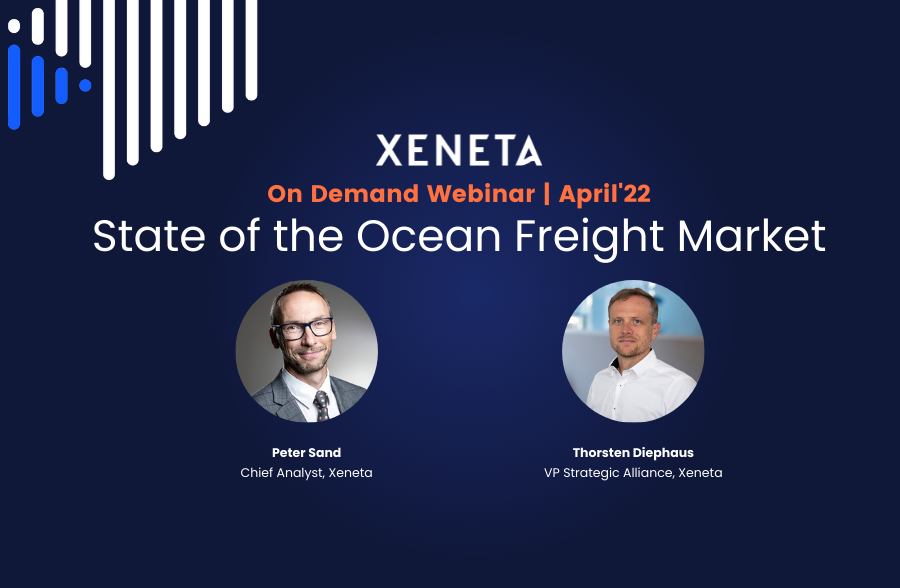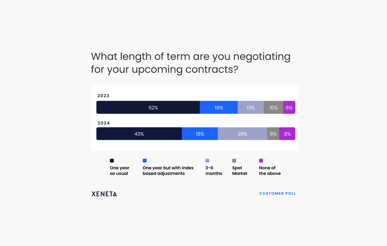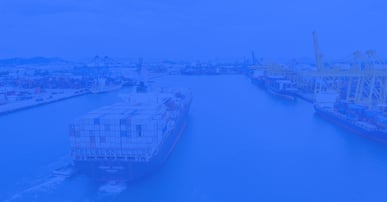As we move into the second quarter of 2022, the global events are contributing to what may be one of the disastrous Q2 for ocean shipping. Watch our April State of the Market webinar for ocean freight to understand how the recent events will impact your tender and procurement strategy in the short- and long-term.
The Ripple Effects of Chinese Lockdowns & US Port Congestion on Ocean Freight Rates
Key Webinar Takeaways
- With low schedule reliability on transatlantic trades, learn what should be top of mind for shippers involved in US trades.
- Find out why shippers need to benchmark now to plan for Q2/Q3 in 2022 as capacity is not expected to ease until the first half of 2023
- Get an expert analysis of major trade lanes
- LIVE Q/A
Watch The Full Webinar Here
Webinar Content and Transcript
Global Container Volume Update 17:45
- Global Rate Trends - 26:00
- Schedule Reliability Far East - US West Coast- 31:10
- Capacity on US East Coast - 32:28
- North EU - Far East (REEFER) - 34:00
- Far East - North EU - 37:10
- North EU - US East Coast - 39:00
- Far East - US West Cost - 39:38
- Far East - US East Coast - 41:00
Congestion on US Coast - 50:00
Top of Mind Tips Q2 022 - 58:00
Courtney Sherwin Sr. Demand Generation Manager Xeneta: Hi everyone and welcome to the state of the market ocean freight webinar for April 2022. We're going to talk about the rippling effects of the Chinese lockdown and the US port congestions on ocean freight rates and how they're affecting the trends and the development for these next couple of weeks. We're going to start with an introduction. My name is Courtney Sherwin. I'm the senior demand generation manager at Xeneta and my job today is to make sure you have these smooth, easy experiences during this webinar.
[00:00:33] I'm joined by my two colleagues starting with Thorsten Diephaus the VP of Strategic Alliance. Welcome, Thorsten! Can you please give a quick introduction, a little bit about your background and what you're doing at Xeneta for our viewers today?
[00:00:48] Thorsten Diephaus VP Strategic Alliance Xeneta: Sure. Thanks, Courtney. My name is Thorsten I'm with Xeneta for more than five years and in the logistics industry for unfortunately already almost 20 plus years. And [00:01:00] within Xeneta I am taking care of strategic alliances. I have discussions with our existing customers about the usage of our data, what they would like to see as well, how they can use our data in their daily work and what is really going on in the markets in general. Thanks for joining today.
[00:01:20] Courtney Sherwin Sr. Demand Generation Manager Xeneta: Thank you, Thorsten. It's going to be a great discussion. Your perspective of the conversations that you're having with our customers is going to bring a lot of value to today's topics. Great to have you. Also joining us today is Peter sand, the chief analyst at Xeneta. Welcome, Peter, please also give a quick introduction to yourself, and to our viewers.
[00:01:41] Peter Sand Chief Analyst Xeneta: Welcome to all of you wherever you are. On the rookie in the business spending less than two decades within the shipping industry and since November 1st, having the pleasure of being your Xeneta, chief analyst with a keen focus on what drives the container shipping market from a shipper perspective, from a lineup perspective.
[00:02:01] And of course also what drives it in the end, the macroeconomic developments, the consumer demand and all the obstacles that are in between the production and the consumption of anything that goes inside a metal box. I'm an economist by training, and I'm very pleased to have Thorsten with me here today, sharing his insights also into the magnificent world of the global container business.
[00:02:27] Courtney Sherwin Sr. Demand Generation Manager Xeneta: Thank you so much for taking part of this today. Good to have you both here. Thank you for that. To our viewers, this is a 60-minute webinar. I know that's a lot of times, so thank you so much for your time appreciate your time being with us today. If you do need to jump off, not to worry, you'll receive a recording afterward tomorrow.
And additionally, since you are here, live, take advantage of asking questions in the question panel to the right of your screen and Thorsten will monitor those questions as we move along. So let's take a look at the agenda for [00:03:00] today. We're going to start with a quick Xeneta introduction, just laying the foundation of where this data is coming from. What is this data that we're analyzing and monitoring we'll then move into where we are now talking about key happenings in the market for April 2022? And then we'll jump into this Xeneta platform analyzing and monitoring the current freight rate trends on major corridors. And lastly, for today's topic, we'll get into the details of the Chinese lockdown in the US port congestion and how that's affecting ocean freight rates. How does that sound Thorsten and Peter, ready to go?
[00:03:38] Thorsten Diephaus VP Strategic Alliance Xeneta: Perfect. Thanks.
[00:03:40] Peter Sand Chief Analyst Xeneta: Especially hearing your first comments here on presenting Xeneta, because well, crowdsourcing from our customers is well basically a part of the secret success behind making use of Xeneta is the perfect and most efficient way. So I'm just eager to get going, take it away.
[00:03:59] Courtney Sherwin Sr. Demand Generation Manager Xeneta: [00:04:00] Great. Good to hear. So Xeneta is the world's largest database for the ocean and air freight rates. Today we're just concentrating on the ocean and this slide kind of pinpoints the facts and figures of Xeneta. We have over 450 million data points on our platform. But the key number that I want to hone in on here is that bottom left number 10 million new rates per month.
[00:04:23] And I want to pinpoint that because that allows us to have real-time transparency of what's happening on the mobile and having ultimately the data-driven discussions that you can have with your suppliers and customers. So where does this data come from? The data is collected, as Peter mentioned, from our customers. Our customers are companies like yourselves. We collect over 20 billion US dollars of purchasing power from our shipping community. The majority of this data is long-term ocean freight rate contracts. So anything with a validity of 90 days, [00:05:00] one year, three years, that data is collected and put into the platform.
[00:05:04] Additionally, we also collect data from our freight forwarding customers. This data is FAK and spot market. Having this long-term and the short-term market on the platform allows us to analyze both markets. And lastly, we do not collect data from carriers. We do not collect data from shipping lines. We have all three stakeholders on the Xeneta platform because we want to build that transparency of what's happening in the market while staying neutral.
[00:05:32] As I mentioned, you can have those data-driven discussions based on current data. So let's dig into the data a little bit. How do we collect it? Starting from the bottom here, the data is collected by rate sheets, Excel files, and PDFs. We then have an in-house rate management team that cleanses, normalizes and validates this data. This is a key piece of the puzzle because, without it, we can't really have that accurate, [00:06:00] real-time data that we're going to look at today- that market high, the market low, and the market average, to be able to see the complete spreadable.
[00:06:09] All right. That was very quick. If you have any questions about this Xeneta platform or the data, write them in the question panel and I will monitor them now. Otherwise, I'm going to pass the mic over to Thorsten and Peter.
[00:06:22] Peter Sand Chief Analyst Xeneta: Thank you so much, Courtney. And without further ado, let's just deep dive into what, where are we now? In short, besides being here on the 21st of April, we have four things that we would like to pinpoint for you today.
[00:06:40] The first one, the spot market trend is split on the main trait. And what do I mean by that? The fact that we have seen the disruptions in China has definitely also developed, or further, amplified the trends that we have already seen, [00:07:00] where weak demand from Asia into Europe has also meant that spot rates have been driven further down than on any other trade. Perhaps with the South American trait being the exception here, but on the main long haul traits into Europe or North America. The split between the main trade lanes is now quite significant in that sense. Still fairly steady on the spot market into US West Coast with a certain say arrow a little bit up firming on the US East Coast and that is a part of what we're going to deep dive into a little bit further. Those were the front hauls of the main trade lanes. Thorsten, can you share a bit about the trends that we see on the backhaul of some of the main trades?
[00:07:52] Thorsten Diephaus VP Strategic Alliance Xeneta: Everyone realized last year's main trades were more or less .... Increasing day by day. We've seen the end of last year already that on the backhaul [00:08:00] trades that on the spot market, the rates are going down already. Not to the same level as we have seen before, for sure not. And especially what we do see is that the market low, what we display is far higher compared to the previous year. So therefore it's a question with all the markets, the markets are going down in the backhaul already for a longer time? Do we ever reach again, the very low rate levels? What we have seen in the past or will be the new, very low level, far higher compared to the previous years what we have seen. And this is one of the topics that we are currently investigating as well. What's going on - overall backhaul trades are on a downward trend.
[00:08:42] Peter Sand Chief Analyst Xeneta: I think that dominates them all, the ring to rule them all. What goes on in China? What happens to exports out of Asia, out of China as the main driver? The current disruptions that we see right now, moving from the south, the Pearl River Delta Shenzhen and all the disruptions that we will basically also talk about more than half a year ago when <inaudible> was one of the main lockdowns that disrupted the supply chains. Some argued that it was more significant than the blockage of the Suez Canal by the end of March.
But I think the one that tops them all right now is the still ongoing lockdown in and around the greater Shanghai area. Surely something that is much more critical when it takes place in the big export port, in the world impacts not only the long haul out of the region, but certainly also a lot of Intra Asian business.
[00:09:42] This is affecting everyone. Many of you must have felt an urgent need in order to either redirect your cargo which was already on the move or basically has say obstacles set up right now in front of you with cargo, just being stuck [00:10:00] somewhere. All expectations for the coming weeks and months, especially around Shanghai are that this is going to take quite some time.
[00:10:10] My own expectations are for this to, gradually ease over a period of time, say four to eight weeks. So I guess patience has always been required. And I guess we can only encourage every one of you to be on your toes, and work with your district partners. And of course, make use of the Xeneta platform to not only monitor the most recent developments in real-time in the market but surely also to analyze the developments and find out what is actually going on.
[00:10:41]A few of the main shippers that we have in the market have got fed up with waiting for <inaudible> they have been promised much better schedule reliability, much-improved service for quite some time now. And only until recently, have we seen a constant decline in schedule reliability from the carriers. When we get into the Xeneta platform shortly, I won't give you a little bit more insights, courtesy of our partners Sea Intelligence.
[00:11:10] The one point that I'm hitting on here is the German retailer Lidl setting up their own shipping company, Tailwind Shipping. But they come already on the back of several US shippers that have tried or still trying their luck in being a shipping company -a miss the worst supply chain crisis in history. I wish them all the best of luck, but I can surely understand where they come from. And I think they also need that extra skill in order to do it better than the current logistics professionals in freight forwarding in line of business are already doing.
[00:11:50] Thorsten Diephaus VP Strategic Alliance Xeneta: Shippers are starting their own line of business that's for sure not because of saving money, it's because of a supply chain [00:12:00] security and that really means that in the last 20 years logistics was always seen as a cost factor only, which you need to reduce - you need to reduce logistics cost, buy at a lower price optimize everything. And probably that's really a shift in the whole strategic outreach that they really say, look supply chain for us is so important that we are really now investing money as well. Yeah, we know it cost probably a bit more, but we have a certain kind of flexibility and Lidl is not the first one. There were others. And the question will be where else do probably shipper invest their money as well, to get a supply chain, which is better equipped against future interruptions.
[00:12:46] And that they're really from C-level because I know from my discussion with our customers. Logistics is at C- level everywhere because people have 150%, 200% higher budget on transportations. And this is really a crucial point now -how strategic is this topic now in the near future as well?
[00:13:06] Peter Sand Chief Analyst Xeneta: I think one of the permanent agenda items for any board meeting with main shippers these days is how can we improve the resilience of our global supply chains? And I think the jury is still out on the dominant strategy. It will, of course, be very company-specific. But if I were to set the range, it would be anywhere from having say, okay, let's put more goods in stock. Let's say front load more cargo ahead of our main sales seasons to the other end of the scale, where you completely relocate your manufacturing facilities to bring them back to where your main consumer base is. If I were to, give it a go in terms of where I expect that dominant strategy to sit, it could [00:14:00] be somewhere a little bit to the left.
[00:14:03] It could be in the sense that you're not only bringing goods into your stock. Everybody is doing that full stop a no-brainer, but you will see also a strategy where the location of manufacturing is moving to other locations within the Asian region. I don't see a dominant strategy where all manufacturing facilities are relocated to a nearshoring or a place just next to your consumers.
[00:14:34] That seems to be at least to me, the most expensive option. So only a few will go for that. But somewhere where you put up just in time supply chains, which are already there next to just-in-case supply chains that come at a much higher price tag but maybe the one thing that you are seeking right now, in extent, of course also adding to a closer relationship to your key logistics provider.
And I think that's something that we will also see when, going into the Xeneta platform shortly, a lot of shippers and carriers are seeking to forge closer relationships. And I'm not only talking about the wider offering where some lines are offering now say <inaudible> logistics end to end. But surely just moving from the spot market to the long-term contract market, there is resilience, at least in theory, to take away from such a move. The one thing that I would like to pinpoint where are we now is a little bit of discussion in terms of where are we actually expecting global demand for container shipping to be by the end of 2022. It would be a no-brainer and it seems to be the consensus view that okay, container shipping demand will grow 3-4%. I would like to open up a little bit of a discussion on whether that is actually really what we are expecting and what we are most likely to see and, allow me to introduce a few illustrations to support that view, or at least give you some insights to understand the dynamics behind that.
[00:16:18] And of course, you are the master of your own logistics. But if you lift yourself up into the helicopter, this may be insights into also the future developments of the spot market, as well as the long-term contract market.
[00:16:34] The first one I would like to touch on here is the 2022 January and February volumes as compared to past years. And if you can see to the left-hand side I have bundled the dry market and the reefer market. As you may know, approximately 90% of the total market is dry and 10% in reefers, in total. January or February volumes in 2022, are only up by just shy of 6% as compared to the pre-pandemic, January and February in 2019.
[00:17:10] So it's actually not a lot on a global scale and the same can be set for the full years. If you compare 2020. One two, the pre-pandemic for the global scale, it's actually not massive say fundamental demand that has been created, pushing up freight rates at large, but it is the structure and the nature of this completely topsy-turvy market, which is very much driven by the American consumers.
[00:17:42] Let's get a little bit further into this discussion. Global container volumes illustration, courtesy of CTS here, of how the market has basically continued to weaken since September of last year. It was only a little in the beginning, but it actually contracted in September, October, November, and December. January numbers were slightly up. But if you put it in combination with the deeper fall in February, you have a contraction of global volumes going into 2022 from the previous year, the record year of 2021, by the extent of 2.4%. So there is something going on and you can also easily expect that much data once they come out. We'll also see what we know from reading into the tea leaves of the freight rate on the Xeneta platform, that volumes moved in March were down in 2022 as compared to the previous year. April is most likely the same.
[00:18:49] So there is clearly a trend here. So if we are expecting, if I were to call it the consensus demand growth for around 3 to 4%, you really need to ship [00:19:00] a lot of volumes, not only ahead of say your main seasons and your normal peak seasons, but you need a China not closing down every single day. The American consumers will support the market, but can the facilities in the main producing areas in Asia, keep it up. I guess that is the big question.
[00:19:25] Illustrating my final point here on talking about the global demand. On the right-hand side, you have an illustration of how scoot the market has been to watch the transpacific trade lane, or at least everything that goes into North America from the Far East. Growth from the pre-pandemic year of 2019, as compared to the record-breaking year in 2021, is almost 27% up on the North American trade as compared to a little less than 3% in Europe. [00:20:00] So it's not a no-brainer in any sense to expect demand, to keep growing, on the contrary, it could easily be flat. It could also be negative.
[00:20:12] To you as a shipper, of course, that insight will be useful in the extent to also know that carriers will from the very start of 2023 receive a lot of new ships that will be fed into the services and we'll also say amplify some of the trends that I'm talking about right here, right now, in terms of easing some of the strains in the current supply chains further than what we have recently seen.
[00:20:44] The final point I would like to touch on before going into the Xeneta platform, of course, giving you a little bit of update on what we talked about with Harry Broadman, research head at the Berkeley research group, one month ago. Those of you who follow the state of the ocean webinar back then would know that we talked a lot about the dynamics of geopolitics. We talked a lot about the disruptions arising from the conflict between Russia and Ukraine.
[00:21:18]As you can see here, courtesy of Vessels Value, the post-invasion deadline is 28 February. And you can clearly see that 20 to 30% of imports via Russian Pacific ports have been more or less undisrupted. Whereas the cargos going into Russia via the Baltic and the Black Sea have been massively impacted by the crisis. And of course also further disrupting the Far East to Europe trade lane and these feeder services Intra Europe in <inaudible> in north Europe and of course, specifically into the Black Sea.
[00:22:03] So just giving you a brief update on that. And of course also an illustration of renewed dislocation of equipment that may get back to you with a whip in a few months' time, but also what we're hearing in terms of of of the equipment shortage you right now from our customers is that it doesn't appear to be a massive problem, at least around Europe right now for main types of equipment. Whereas there may be more of an issue in North America.
[00:22:42] Thorsten do you have any specific insights, to share from your sources in terms of what happens to the market when something like the Ukrainian Russian crisis emerges like it has been doing [00:23:00] now.
[00:23:00] Thorsten Diephaus VP Strategic Alliance Xeneta: We all know that carriers do not serve the market. Some carriers do not, but not everyone we have Chinese carriers, they just serve the market. As it has been normal we see a trucker shortage. We know that containers are still not unloaded, partly because they are parked somewhere on the terminals and a lot of export volume from Ukraine because from the food industry grain and so on is disappearing. They won't export it.
So therefore they have fewer cords and that whole area, but as well probably less production side -what they do produce. And the impact on the overall shipping of the war is probably not as big as some other impacts that we will discuss later on, which will influence the whole shipping business far more than the war at the moment...
Watch the full webinar and understand how global events may impact your tender and procurement strategies.








